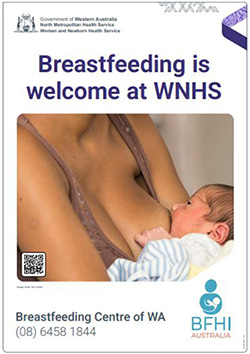Baby Friendly Health Initiative

BFHI is a joint World Health Organisation (WHO) and UNICEF project that aims to create a health care environment where breastfeeding is the norm, and practices known to promote the wellbeing of mothers and their babies are promoted. The standards embedded in the Ten Steps to Successful Breastfeeding are the global criteria against which maternity hospitals are assessed and accredited.
In a Baby friendly facility, a mothers informed choice of infant feeding is encouraged, respected and supported. At no time are mothers forced to breastfeed. The Ten Steps to Successful Breastfeeding are beneficial to all mothers and babies promoting bonding parental responsiveness empowerment and informed choice regardless of feeding method.
Ten Steps to Successful Breastfeeding
Critical Management Procedures
Step 1
- Have a written infant feeding policy that is routinely communicated to staff and parents.
- Comply fully with the international code of marketing of breastmilk substitutes and relevant world health assembly resolutions.
- Establish ongoing monitoring and data-management systems.
Step 2
Ensure that staff have sufficient knowledge, competence and skills to support breastfeeding.
Key Clinical Practices
Step 3
Discuss the importance and management of breastfeeding with pregnant women and their families.
Step 4
Facilitate immediate and uninterrupted skin-to-skin contact and support mothers to recognise when their babies are ready to breastfeed, offering help if needed.
Step 5
Support mothers to initiate and maintain breastfeeding and manage common difficulties.
Step 6
Do not provide breastfed newborns any food or fluids other than breastmilk, unless medically indicated.
Step 7
Enable mothers and their infants to remain together and to practise rooming-in 24 hours a day.
Step 8
Support mothers to recognise and respond to their infants’ cues for feeding.
Step 9
Counsel mothers on the use and risks of feeding bottles, teats and pacifiers.
Step 10
Coordinate discharge so that parents and their infants have timely access to ongoing support and care.

